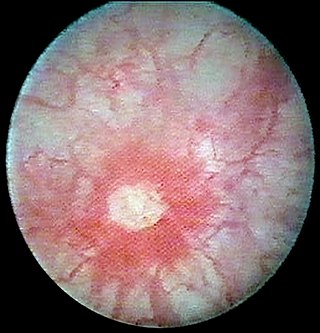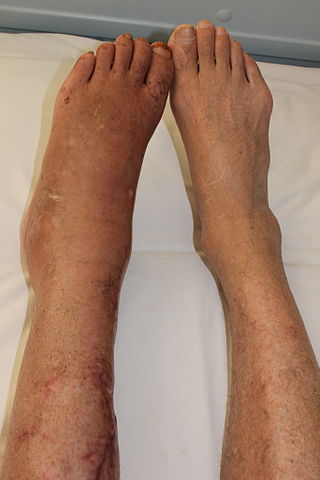Runner's knee may refer to a number of overuse injuries involving pain around the kneecap (patella), such as:
Runner's knee may refer to a number of overuse injuries involving pain around the kneecap (patella), such as:

Interstitial cystitis (IC), a type of bladder pain syndrome (BPS), is chronic pain in the bladder and pelvic floor of unknown cause. It is the urologic chronic pelvic pain syndrome of women. Symptoms include feeling the need to urinate right away, needing to urinate often, and pain with sex. IC/BPS is associated with depression and lower quality of life. Many of those affected also have irritable bowel syndrome and fibromyalgia.
PCS may refer to:

Complex regional pain syndrome is a form of amplified musculoskeletal pain syndrome (AMPS) in which pain from a physical trauma outlasts the expected recovery time. The symptoms and causes of Type 1 and 2 are the same except Type 2 is caused by a nerve injury and is typically much more painful. This type of AMPS must include a specific cause and is often accompanied by various visible changes, such as skin changes. The lack of an observed cause for the condition, or the lack of visible symptoms, creates the diagnosis of diffuse amplified pain.

Ehlers–Danlos syndromes (EDS) are a group of 13 genetic connective-tissue disorders in the current classification, with the latest type discovered in 2018. Symptoms often include loose joints, joint pain, stretchy velvety skin, and abnormal scar formation. These may be noticed at birth or in early childhood. Complications may include aortic dissection, joint dislocations, scoliosis, chronic pain, or early osteoarthritis.

Fibromyalgia is a medical condition defined by the presence of chronic widespread pain, fatigue, waking unrefreshed, cognitive symptoms, lower abdominal pain or cramps, and depression. Other symptoms include insomnia and a general hypersensitivity.

A phantom limb is the sensation that an amputated or missing limb is still attached. Approximately 80–100% of individuals with an amputation experience sensations in their amputated limb. However, only a small percentage will experience painful phantom limb sensation. These sensations are relatively common in amputees and usually resolve within two to three years without treatment. Research continues to explore the underlying mechanisms of phantom limb pain (PLP) and effective treatment options.

Chest pain is pain or discomfort in the chest, typically the front of the chest. It may be described as sharp, dull, pressure, heaviness or squeezing. Associated symptoms may include pain in the shoulder, arm, upper abdomen, or jaw, along with nausea, sweating, or shortness of breath. It can be divided into heart-related and non-heart-related pain. Pain due to insufficient blood flow to the heart is also called angina pectoris. Those with diabetes or the elderly may have less clear symptoms.

Abdominal pain, also known as a stomach ache, Is a symptom associated with both non-serious and serious medical issues. Since the abdomen contains most of the body's vital organs, it can be an indicator of a wide variety of diseases. Given that, approaching the examination of a person and planning of a differential diagnosis is extremely important.

The piriformis muscle is a flat, pyramidally-shaped muscle in the gluteal region of the lower limbs. It is one of the six muscles in the lateral rotator group.

Tarsal tunnel syndrome (TTS) is a nerve entrapment syndrome causing a painful foot condition in which the tibial nerve is compressed as it travels through the tarsal tunnel. This tunnel is found along the inner leg behind the medial malleolus. The posterior tibial artery, tibial nerve, and tendons of the tibialis posterior, flexor digitorum longus, and flexor hallucis longus muscles travel in a bundle through the tarsal tunnel. Inside the tunnel, the nerve splits into three segments. One nerve (calcaneal) continues to the heel, the other two continue on to the bottom of the foot. The tarsal tunnel is delineated by bone on the inside and the flexor retinaculum on the outside.

Hypermobility, also known as double-jointedness, describes joints that stretch farther than normal. For example, some hypermobile people can bend their thumbs backwards to their wrists and bend their knee joints backwards, put their leg behind the head or perform other contortionist "tricks". It can affect one or more joints throughout the body.
Burning mouth syndrome (BMS) is a burning, tingling or scalding sensation in the mouth, lasting for at least four to six months, with no underlying known dental or medical cause. No related signs of disease are found in the mouth. People with burning mouth syndrome may also have a subjective xerostomia, paraesthesia, or an altered sense of taste or smell.

Precordial catch syndrome (PCS) is a non-serious condition in which there are sharp stabbing pains in the chest. These typically get worse with inhaling and occur within a small area. Spells of pain usually last less than a few minutes. Typically it begins at rest and other symptoms are absent. Concerns about the condition may result in anxiety.
FRPS may refer to:
Three different neurological syndromes carry the name of Ramsay Hunt syndrome. Their only connection is that they were all first documented by the famous neurologist James Ramsay Hunt (1872–1937).
Dejerine–Roussy syndrome or thalamic pain syndrome is a condition developed after a thalamic stroke, a stroke causing damage to the thalamus. Ischemic strokes and hemorrhagic strokes can cause lesioning in the thalamus. As initial stroke symptoms dissipate, an imbalance in sensation causes these later syndromes, characterizing Dejerine–Roussy syndrome. Although some treatments exist, they are often expensive, chemically based, invasive, and only treat patients for some time before they need more treatment, called "refractory treatment".
The acronym RSDS may refer to:

Cracked tooth syndrome (CTS) is where a tooth has incompletely cracked but no part of the tooth has yet broken off. Sometimes it is described as a greenstick fracture. The symptoms are very variable, making it a notoriously difficult condition to diagnose.
Chiari syndrome or Chiari's disease may refer to one of the following diseases named after the 19th century Austrian pathologist Hans Chiari:

Chronic fatigue syndrome (CFS), also called myalgic encephalomyelitis (ME) or ME/CFS, is a complex, debilitating, long-term medical condition. Core symptoms are lengthy flare-ups of the illness following ordinary minor physical or mental activity, known as post-exertional malaise (PEM); greatly diminished capacity to do tasks that were routine before the illness; and sleep disturbances. The US Centers for Disease Control and Prevention's (CDC) diagnostic criteria also require at least one of the following: (1) orthostatic intolerance or (2) impaired memory or attention. Frequently and variably, other symptoms occur involving numerous body systems, and chronic pain is very common. The often incapacitating fatigue in ME/CFS is different from that caused by normal strenuous exertion, is not significantly relieved by rest, and is not due to a previous medical condition. Diagnosis is based on the person's symptoms because no confirmed diagnostic test is available.